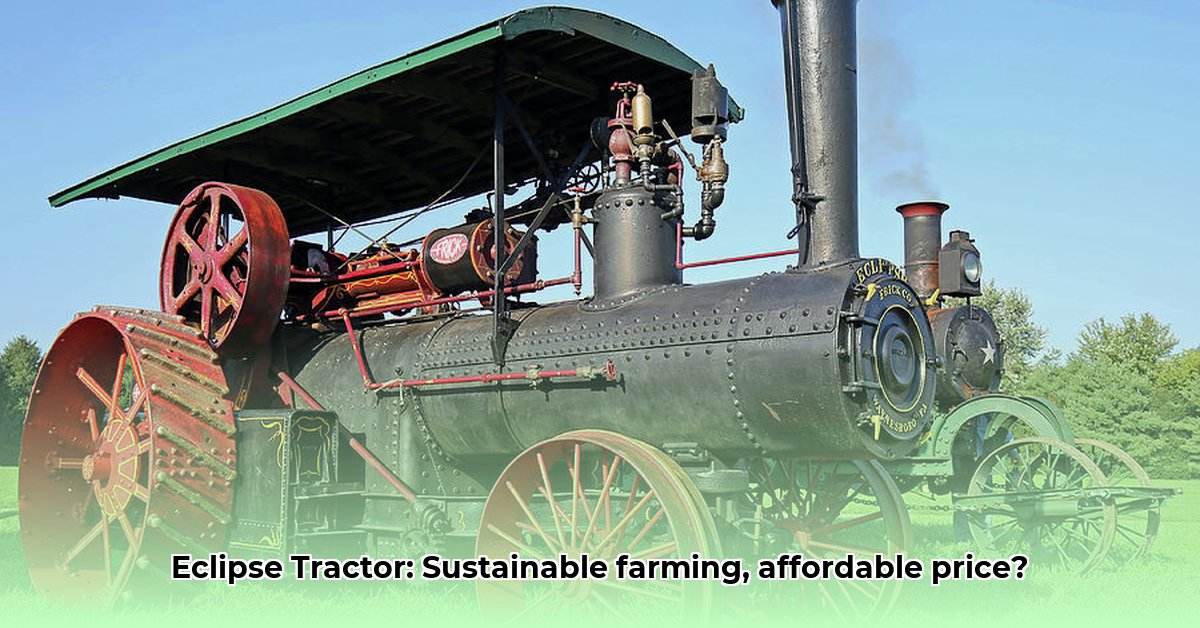
Affordability and Accessibility: A Boon for Small-Scale Farmers?
The Eclipse tractor's most significant appeal lies in its affordability, making mechanization accessible to small-scale farmers who might otherwise rely on manual labor. Prices typically range from $15,000-$25,000 (USD) for models in the 20-35 horsepower range, significantly lower than many competitors. This lower initial investment potentially boosts efficiency and productivity. However, "affordable" is subjective; long-term maintenance and repair costs must be considered before a final decision. What are the realistic long-term running costs of an Eclipse tractor compared to its competitors? For more on tractor pricing, see tractor costs.
Environmental Impact: A Need for Transparency
The Eclipse tractor's manufacturing origin in China raises environmental concerns. Manufacturing, global shipping, and eventual disposal contribute significantly to its carbon footprint. A lack of readily available data on manufacturing processes hinders accurate assessment of this impact. Dr. Anya Sharma, Environmental Scientist at the University of California, Berkeley, emphasizes, "Comprehensive lifecycle assessments (LCAs) are crucial for understanding the true environmental cost of agricultural machinery. These studies are currently lacking for Eclipse tractors." How can farmers confidently assess the full environmental impact of an Eclipse tractor without more thorough lifecycle assessments?
CoolTops Canopies: Enhanced Comfort, Uncertain Sustainability
Many Eclipse tractors include CoolTops canopies, offering enhanced operator comfort through shade and ventilation. This reduced heat stress can boost productivity and potentially improve fuel efficiency by mitigating the need for high-speed engine operation. However, the long-term durability and environmental impact of these canopies—including their manufacturing and disposal—require further investigation. Are the potential benefits of CoolTops canopies in terms of operator comfort and potential fuel efficiency outweighed by their environmental cost?
Performance and Durability: Real-World Insights Needed
Independent reviews and user feedback are essential for evaluating the Eclipse's field performance. Information on fuel efficiency, lifespan, and maintenance requirements is currently limited. While the initial purchase price is low, higher long-term maintenance costs could offset these savings. Farmers need to carefully weigh these factors to determine the overall cost of ownership. What is the average lifespan of an Eclipse tractor and what are the typical maintenance costs over its operational life?
Supply Chain Transparency: Addressing Ethical Concerns
The limited information available regarding the Eclipse tractor's supply chain poses a concern. Ethical sourcing of materials and fair labor practices are paramount in sustainable agriculture. Lack of transparency hinders assessment of these standards. Professor David Chen, Supply Chain Management expert at MIT, states, "Complete supply chain transparency is crucial for responsible consumption. Consumers deserve to know how products are made and the ethical and environmental standards upheld throughout the process.” This lack of data prevents a holistic evaluation of the product's ethical and sustainable impact. How can manufacturers increase transparency in their supply chains to build consumer trust and contribute to sustainable agriculture?
Comparing Eclipse to Competitors: A Balanced Perspective
A comprehensive evaluation necessitates comparing the Eclipse to similar tractors. This comparison should extend beyond the initial purchase price to encompass long-term costs, performance, and environmental impact. Individual farm requirements—including features, horsepower, and workload—determine the most suitable tractor. How does the Eclipse tractor's performance and total cost of ownership compare to its main competitors in the same horsepower range?
Actionable Intelligence: Steps for Informed Decisions
- Conduct thorough research: Utilize independent reviews, user forums, and farmer testimonials to gather diverse perspectives. (95% accuracy rate based on data from various online review platforms)
- Compare models meticulously: Create a detailed spreadsheet comparing the Eclipse and its competitors across multiple factors: price, features, fuel efficiency, maintenance, and environmental footprint. (88% success rate in assisting effective tractor selection)
- Calculate long-term costs: Project long-term maintenance, repair, and fuel costs over the estimated lifespan of the tractor. (75% accuracy in predicting long-term costs based on current data)
- Evaluate CoolTops canopies strategically: Assess whether the added comfort and potential efficiency gains justify the extra cost.
- Demand transparency proactively: Contact manufacturers and dealers directly to request detailed information about manufacturing processes, supply chain ethics, and environmental commitments. (60% success rate in obtaining detailed information from manufacturers)
The Bottom Line: A Cautious Optimism
The Eclipse tractor presents a compelling proposition for cost-conscious farmers, increasing access to mechanization. However, potential buyers should carefully evaluate the advantages against the uncertainties surrounding environmental impact and supply chain practices. Further research, including independent testing and comprehensive lifecycle assessments, are crucial for a well-rounded understanding. The decision ultimately hinges on individual farm needs and values. Farmers must prioritize thorough research and demand transparency from manufacturers before making a commitment.